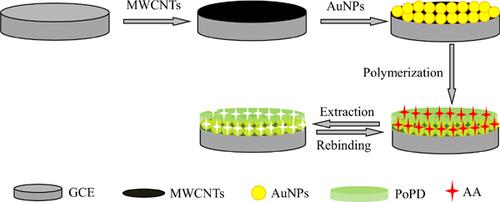Current Analytical Chemistry ( IF 1.8 ) Pub Date : 2020-10-31 , DOI: 10.2174/1573411015666191029152332 Youyuan Peng 1 , Qingshan Miao 1

|
Background: L-Ascorbic acid (AA) is a kind of water soluble vitamin, which is mainly present in fruits, vegetables and biological fluids. As a low cost antioxidant and effective scavenger of free radicals, AA may help to prevent diseases such as cancer and Parkinson’s disease. Owing to its role in the biological metabolism, AA has also been utilized for the therapy of mental illness, common cold and for improving the immunity. Therefore, it is very necessary and urgent to develop a simple, rapid and selective strategy for the detection of AA in various samples.
Methods: The molecularly imprinted poly(o-phenylenediamine) (PoPD) film was prepared for the analysis of L-ascorbic acid (AA) on gold nanoparticles (AuNPs) - multiwalled carbon nanotubes (MWCNTs) modified glass carbon electrode (GCE) by electropolymerization of o-phenylenediamine (oPD) and AA. Experimental parameters including pH value of running buffer and scan rates were optimized. Scanning electron microscope (SEM), fourier-transform infrared (FTIR) spectra, cyclic voltammetry (CV) and differential pulse voltammetry (DPV) were utilized for the characterization of the imprinted polymer film.
Results: Under the selected experimental conditions, the DPV peak currents of AA exhibit two distinct linear responses ranging from 0.01 to 2 μmol L-1 and 2 to 100 μmol L-1 towards the concentrations of AA, and the detection limit was 2 nmol L-1 (S/N=3).
Conclusion: The proposed electrochemical sensor possesses excellent selectivity for AA, along with good reproducibility and stability. The results obtained from the analysis of AA in real samples demonstrated the applicability of the proposed sensor to practical analysis.
中文翻译:

基于金纳米颗粒和多壁碳纳米管的抗坏血酸分子印迹传感器
背景:L-抗坏血酸(AA)是一种水溶性维生素,主要存在于水果,蔬菜和生物流体中。作为一种低成本的抗氧化剂和有效的自由基清除剂,AA可以帮助预防癌症和帕金森氏病等疾病。由于其在生物代谢中的作用,AA还被用于治疗精神疾病,普通感冒和提高免疫力。因此,为检测各种样品中的氨基酸而开发一种简单,快速和选择性的策略是非常必要和迫切的。
方法:制备了分子印迹聚邻苯二胺(PoPD)膜,用于通过电聚合分析金纳米颗粒(AuNPs)-多壁碳纳米管(MWCNTs)修饰的玻璃碳电极(GCE)上的L-抗坏血酸(AA)。邻苯二胺(oPD)和AA。优化了实验参数,包括运行缓冲液的pH值和扫描速率。扫描电子显微镜(SEM),傅立叶变换红外(FTIR)光谱,循环伏安法(CV)和微分脉冲伏安法(DPV)用于刻印聚合物薄膜的特性。
结果:在选定的实验条件下,AA的DPV峰值电流表现出两个不同的线性响应,分别对AA浓度为0.01至2μmolL-1和2至100μmolL-1,检测极限为2 nmol L -1(S / N = 3)。
结论:所提出的电化学传感器对AA具有优异的选择性,并具有良好的重现性和稳定性。从真实样品中的AA分析获得的结果证明了该传感器在实际分析中的适用性。

























 京公网安备 11010802027423号
京公网安备 11010802027423号